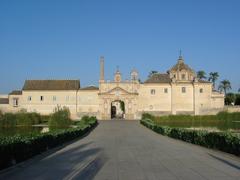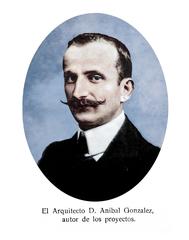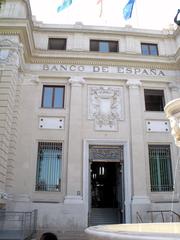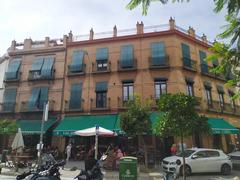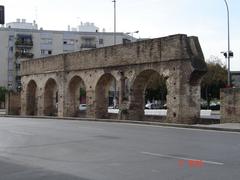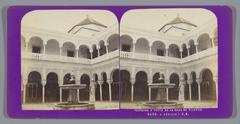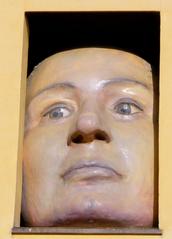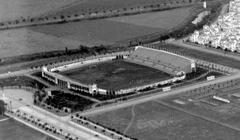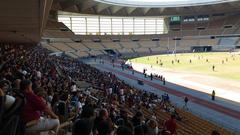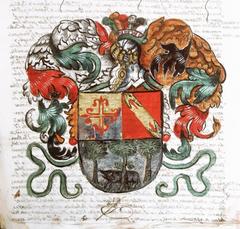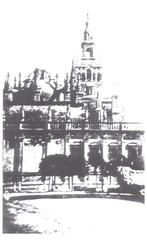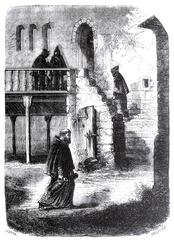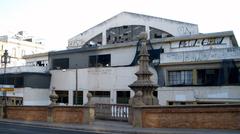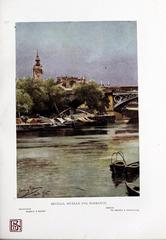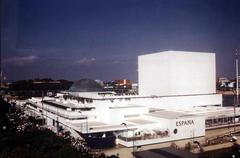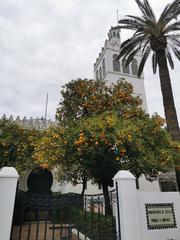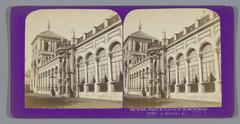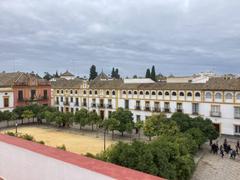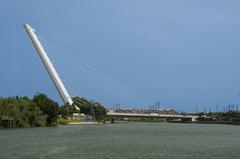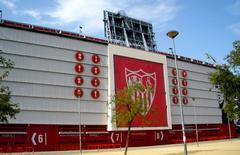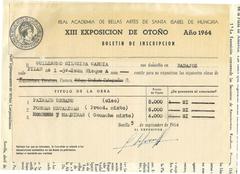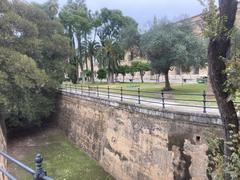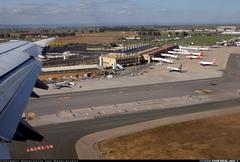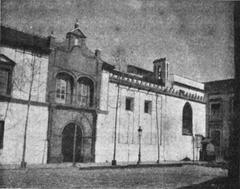Edificio De Oficinas Sevilla 1: Visiting Hours, Tickets, and Guide to Seville’s Modern Architectural Landmark
Date: 14/06/2025
Introduction
Edificio De Oficinas Sevilla 1 is a pivotal example of Seville’s architectural evolution, symbolizing the city’s transition from its storied historical roots to contemporary urban and economic dynamism. Located in the Nervión district, this modernist office building—constructed between 1969 and 1972—stands out for its rationalist design and its role in shaping Seville’s modern business landscape. Whether you are an architecture aficionado, a business traveler, or a visitor seeking to understand Seville’s diverse built environment, this comprehensive guide provides essential information on its history, architectural significance, visitor access, and surrounding attractions.
Table of Contents
- Introduction
- Historical Context and Urban Transformation
- Architectural Design and Significance
- Visitor Information
- Facilities, Services, and Office Space
- Comparative Analysis with Seville’s Landmarks
- Sustainability and Urban Legacy
- Frequently Asked Questions (FAQ)
- Visuals and Media Recommendations
- Related Links and Resources
- Conclusion and Call to Action
Historical Context and Urban Transformation
Origins and Setting
Edificio De Oficinas Sevilla 1 emerged as a landmark of rationalist and modernist architecture during a period when Seville was experiencing significant demographic and economic expansion. Situated along Avenida San Francisco Javier in Nervión, the building was conceived as part of a broader urban effort to create a new commercial axis, distinct from the city’s historic Gothic, Mudéjar, and Baroque quarters (Sevilla Siglo Veinte). The 1970s urban planning initiatives in Nervión fostered the growth of business and administrative sectors, shifting the district from residential and light industrial uses to a thriving commercial hub.
Urban Impact and Cultural Recognition
Edificio Sevilla 1 played a transformative role in redefining Seville’s business identity. Its completion set a precedent for future developments in Nervión and contributed to the district’s evolution into a prominent business center. The building holds the distinction of being recognized as a “Bien de Interés Cultural” (BIC), underscoring its status as an architectural and urban asset (Sevilla Siglo Veinte).
Architectural Design and Significance
Modernist Influences
Designed by Luis Fernando Gómez Estern and Manuel Trillo de Leyva, Edificio Sevilla 1 epitomizes rationalist architectural principles, characterized by geometric clarity, clean lines, and a focus on functional efficiency. The façade is defined by repetitive precast concrete modules and large glass panels, maximizing natural light and offering a transparent, open visual dialogue with the surrounding urban landscape (docomomoiberico.com).
Technical Innovations and Urban Integration
The building features two distinct volumes: one housing vertical circulation (stairs and elevators), and the other dedicated to flexible office modules. This modular approach allowed for adaptable interior layouts, catering to the needs of diverse businesses. Elements such as advanced HVAC systems, energy-efficient glazing, and provisions for accessibility reflect the period’s forward-thinking design (Nuroa).
Careful integration with the city’s urban fabric ensured that the building’s scale respected Seville’s traditional skyline, while landscaped public spaces and retail on the ground floor promoted vibrant street life (spain.info).
Visitor Information
Visiting Hours and Tickets
Edificio De Oficinas Sevilla 1 primarily functions as an office building and is not open for general public tours. Exterior viewing is available at any time, as the building is situated in a public area. There are no ticket requirements or entrance fees to view the exterior. Access to office spaces and interior amenities is limited to tenants and registered guests during standard business hours, typically Monday to Friday, 9:00 AM to 6:00 PM (Nuroa).
Guided architectural tours and special events occasionally include the building as part of broader explorations of Seville’s modernist landmarks. For such opportunities, consult Turismo Sevilla and local event calendars.
Accessibility
The building and its surroundings are designed for accessibility, with ramps, elevators, adapted restrooms, and accessible entrances. The Nervión district is well-served by public transportation, including metro (Nervión station), buses, and proximity to major hubs such as San Bernardo and Santa Justa stations (Turismo Sevilla).
Travel Tips and Nearby Attractions
- Transport: Use Seville’s extensive metro, bus, and tram network for easy access. Taxis and ride-sharing services are widely available.
- Parking: On-site and nearby parking facilities are available, but public transportation is recommended due to limited parking in peak hours.
- Amenities: Cafés, restaurants, and shopping centers like Nervión Plaza are within walking distance. The historic city center, including the Royal Alcázar and Seville Cathedral, is easily reachable via public transit.
- Suggested Itinerary: Combine your visit to Sevilla 1 with nearby modern landmarks such as the Metropol Parasol and classic sites like María Luisa Park.
Facilities, Services, and Office Space
Edificio Sevilla 1 offers a range of facilities for business tenants and authorized visitors:
- Reception and Security: Staffed desks and 24/7 surveillance (Nuroa).
- Flexible Office Space: Modular layouts suitable for small offices and large enterprises alike.
- Meeting Rooms: Equipped with contemporary audiovisual technology.
- Shared Spaces: Lounges, kitchens, and break areas foster collaboration.
- Accessibility: Fully adapted for visitors with reduced mobility.
- Climate Control: Efficient heating and air conditioning ensure year-round comfort.
Prospective tenants should contact building management or commercial real estate agencies for leasing information.
Comparative Analysis with Seville’s Landmarks
While Seville is globally celebrated for its Moorish, Gothic, and Baroque architecture, Edificio Sevilla 1 provides a striking contrast with its minimalist, functional design. Its modernist aesthetic stands alongside the ornate Royal Alcázar, Seville Cathedral, and contemporary icons like the Metropol Parasol, illustrating the city’s rich architectural diversity and its ongoing embrace of innovation (visitsouthernspain.com).
Sustainability and Urban Legacy
Sevilla 1 was a forerunner in incorporating sustainable features such as energy-efficient systems and green spaces into its design—practices that align with the city’s broader urban regeneration initiatives like Seville City One (sevillacityone.com). The building’s legacy as both a business hub and a modern architectural benchmark continues to influence Seville’s urban development.
Frequently Asked Questions (FAQ)
Q: Can I tour the inside of Edificio De Oficinas Sevilla 1?
A: The building is primarily for office use; interior tours are generally not available to the public.
Q: Are there entry fees or tickets?
A: No tickets are required for exterior viewing. Interior access is restricted to tenants and authorized guests.
Q: What are the visiting hours?
A: Exterior viewing is possible at any time. Business hours for tenants and guests are typically Monday to Friday, 9:00 AM to 6:00 PM.
Q: Is the building accessible for people with disabilities?
A: Yes, the building and surrounding area are fully accessible.
Q: How do I get there by public transport?
A: The building is easily accessible via metro (Nervión station), city buses, and is close to Santa Justa railway station (Turismo Sevilla).
Q: Are guided tours available?
A: Occasionally, as part of broader architectural tours—check official Seville tourism platforms for details.
Visuals and Media Recommendations
- Images: High-quality exterior shots and panoramic views are available on tourism and architecture websites. Alt tags should include “Edificio De Oficinas Sevilla 1 rationalist architecture” and “Seville modern office building.”
- Virtual Tours: Explore online archives and tourism portals for virtual tours and detailed photo essays.
- Maps: Interactive maps can help visitors plan their route and locate nearby attractions.
Related Links and Resources
- Sevilla Siglo Veinte: El racionalismo en las oficinas
- Grupo Insur: Edificio Sevilla 1
- Turismo Sevilla: Official Tourism Office
- Docomomo Ibérico: Edificio de Oficinas Sevilla 1
- Nuroa: Office Space Listings
- Spain Info: Seville Province Tourist Office
- Seville City One Initiative
Conclusion and Call to Action
Edificio De Oficinas Sevilla 1 stands as a testament to Seville’s dynamic journey from historical grandeur to modern innovation. Blending rationalist design, urban integration, and business vitality, it enriches the city’s architectural narrative and serves as a landmark of Seville’s modernization. While public access is limited, its striking exterior and location in a vibrant district make it a worthwhile stop for anyone interested in the evolution of Seville’s urban identity.
Plan your visit to discover both Seville’s historical treasures and its modern architectural gems. For up-to-date information on visiting hours, special events, and leasing opportunities, consult official tourism and business resources. Download the Audiala app for tailored travel guides and updates, and follow us on social media to stay connected with Seville’s evolving landscape.
References
- Edificio Sevilla 1: A Guide to Visiting Seville’s Iconic Rationalist Office Building, 2007, Sevilla Siglo Veinte
- Edificio De Oficinas Sevilla 1: Visiting Hours, Tickets & Exploring Seville’s Modern Architectural Gem, 2024, Turismo Sevilla
- Urban and Cultural Impact, 2024, Docomomo Ibérico
- Practical Visitor Information for Edificio De Oficinas Sevilla 1: Office Building in Seville’s Business Districts, 2024, Nuroa
- Spain Info: Seville Province Tourist Office, 2024
